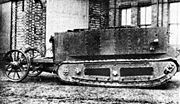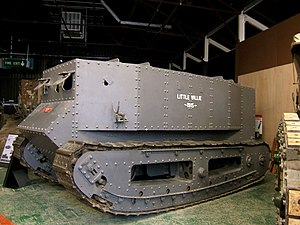| Little Willie | |
|---|---|
|
Little Willie in its later form, with lengthened tracks and without turret at Bovington | |
| Type | Prototype tank |
| Place of origin |
|
| Production history | |
| Designed | July 1915 |
| Manufacturer | Fosters of Lincoln |
| Produced | August–September 1915 |
| No. built | 1 |
| Specifications | |
| Mass | 16.5 tonnes |
| Length |
8.08 m (26 feet 6 inches) 5.87 m (19 ft 3 in) without rear steering wheels |
| Width | 2.86 m (9 ft 5 in) |
| Height |
2.51 m (8 ft 3 in) 9 ft with dummy turret |
| Crew | (Projected) 6 |
|
| |
Main armament | (Projected) Vickers 2-pounder gun |
Secondary armament | (Projected) Approx 6 Madsen machine guns |
| Engine |
Foster-Daimler Knight sleeve valve petrol 105 hp (78 kW) |
| Power/weight | 6 hp/tonne |
| Transmission |
Two-speed forwards, one reverse final drive by Renolds chains |
| Suspension | Unsprung |
| Maximum speed | 2 Mph |

The right side
Little Willie was a prototype in the development of the British Mark I tank. Constructed in the autumn of 1915 at the behest of the Landships Committee, it was the first completed tank prototype in history. Little Willie is the oldest surviving individual tank, preserved as one of the most famous pieces in the collection of the British Bovington Tank Museum.
Number 1 Lincoln Machine[]

The No1 Lincoln Machine, with lengthened Bullock tracks and Creeping Grip tractor suspension, September 1915.
Work on Little Willie's predecessor was begun in July 1915 by the Landships Committee to meet Great Britain's requirement in World War I for a war engine able to cross a 8-foot (2.4m) trench. After several other projects with single and triple tracks had failed, on 22 July William Ashbee Tritton, director of the agricultural machinery company William Foster & Company of Lincoln, was given the contract to develop a "Tritton Machine" with two tracks. It had to make use of the track assemblies - lengthened tracks and suspension elements (seven road wheels instead of four) - provided as fully built units by the Bullock Creeping Grip Tractor Company in Chicago. On 11 August actual construction began; on 16 August Tritton decided to fit a wheeled tail to assist in steering. On 9 September the Number 1 Lincoln Machine, as the prototype was then known, made its first test run in the yard of the Wellington Foundry. It soon became clear that the track profiles were so flat that ground resistance during a turn was excessive. To solve this, the suspension was changed so that the bottom profile was more curved. Then the next problem showed up: when crossing a trench the track sagged and then would not fit the wheels again and jammed. The tracks were also not up to carrying the weight of the vehicle(about 16 tons). Tritton and Lieutenant Walter Gordon Wilson tried several types of alternative track design, including Balata belting and flat wire ropes. Tritton, on 22 September, devised a robust but outwardly crude system using pressed steel plates riveted to cast links and incorporated guides to engage on the inside of the track frame. The track frames as a whole were connected to the main body by large spindles.[1] This system was unsprung, as the tracks were held firmly in place, able to move in only one plane. This was a successful design and was used on all First World War British tanks up to the Mark VIII, although it limited speed.
Description[]
The vehicle's 105 bhp Daimler engine, gravity fed by two petrol tanks, was at the back, leaving just enough room beneath the turret. The prototype was fitted with a non-rotatable dummy turret mounting a machine gun; a Vickers 2-pounder (40 mm) Maxim gun was to have been fitted, with as many as six Madsen machine guns to supplement it.[2] The main gun would have had a large ammunition store with 800 rounds. In practice the turret was removed as it made it top-heavy and the equivalent weight added as ballast in the hull. Stern suggested to Tritton that the turret could be made to slide forward on rails giving a better field of fire although this would have left the top open to shrapnel. In the front of the vehicle two men sat on a narrow bench; one controlling the steering wheel, the clutch, the primary gear box and the throttle; the other holding the brakes. Overall length of the final version with the lengthened tracks and rear steering wheels in place was 8.08 m (26 ft 6 inches). The length of the main unit without the rear steering wheels installed is 5.87 m. Most mechanical components, including the radiator, had been adapted from those of the Foster-Daimler heavy artillery tractor. As at least four men would have been required to operate the armament, the crew could not have been smaller than six. The maximum speed was indicated by Tritton as being no more than two miles per hour. The vehicle used no real armour steel, just boiler plate; it was intended to use 10 mm plating for production.
Little Willie and Big Willie[]

Little Willie showing its rear steering wheels
Wilson was unhappy with the basic concept of the Number 1 Lincoln Machine, and suggested the idea of using tracks that ran all around the vehicle to Tritton on 17 August, he got permission for D'Eyencourt[3] and construction of an improved prototype began on 17 September; for this second Mark I prototype, later known as "His Majesty's Land Ship" (HMLS) Centipede[note 1] or "Mother", a rhomboid track frame was fitted, taking the tracks up and over the top of the vehicle, the rear steering wheels were retained in an improved form, but the dummy turret was removed and replaced by side sponsons holding the armament. Number 1 Lincoln Machine was rebuilt with an extended (90 centimetres longer) track up to 6 December 1915, but merely to test the new tracks in Burton Park; the second prototype was seen as much more promising. The first was renamed Little Willie, the scabrous name then commonly used by the British yellow press to mock the German Imperial Crown Prince Wilhelm; Mother was for a time known as Big Willie, after his father Emperor Wilhelm II of Germany. That same year the cartoonist William Kerridge Haselden had made a popular comic anti-German propaganda movie: The Adventures of Big and Little Willie. In January 1916 Little Willie, now without any turret, contended with Mother for the first production order; its inferiority in crossing trenches decided against it. Though it never saw combat, Little Willie was a major step forward in military technology, being the first tank prototype to be finished (the development of the similar French Schneider CA1 started earlier in January 1915, but its first real prototype was only made in February 1916).
Today[]
Little Willie was preserved for posterity after the war, saved from being scrapped in 1940, and is today displayed at the Bovington Tank Museum. It is essentially an empty hull, without an engine, but still with some internal fittings. The rear steering wheels are not fitted. There is damage to the hull plating around the right–hand vision slit, possibly caused by an attempt at some point to tow the vehicle by passing a cable through the slit. This would have torn the tank's comparatively thin steel plating.[4]
Notes[]
- ↑ Ernest Swinton's idea
References[]
- ↑ Pullen, Richard (2007). "The Landships of Lincoln". Tucann. p. 30. ISBN 978-1-873257-79-1. "New arrival by Tritton out of pressed plate.
Light in weight but very strong.
All doing well, Thank you.
Proud Parents" - ↑ Fletcher, David The British Tanks 1915-1919 p43
- ↑ Fletcher p41
- ↑ "Error: no
|title=specified when using {{Cite web}}". Bovington Tank Museum. 22 March 2010. http://www.youtube.com/watch?v=3fLCdNudUxk. Retrieved 10 May 2011.
External links[]
| |||||||||||||||||||||||||||||
The original article can be found at Little Willie and the edit history here.
